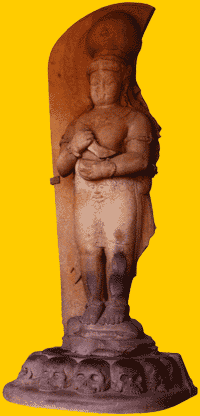|




|
 Bhairava Bhairava
13th - 14th c. Foiund in padang Lawas, West Sumatra
Size: h. 414 cm
Museum Ref: 6470
Facing courtyard
This monumental statue represents the Tantric-Buddhist god, Bhairava, or God of death. The large male figure stands on a corpse resting on a pile of skulls, and holds a cup shaped like a skull in his left hand and a short Arabic-style dagger in his right. The whole iconography of statue is a very good example of syncretism, the mixture of different religious beliefs, predominant at that time. Bhairava is the frightening appearance of shiva (Hinduism) and shows a Buddha in his hair bun (Buddhism). He wears a belt with a representation of Kala on it (Hinduism); the bells hanging from the belt are symbols of Tantrism. Although there is no written proof, it is assumed that this statue was found in a paddy-field in Sungai Langsat during an expedition between 1877 and 1879. Certain parts of it had been exposed for years and without knowing what it was, farmers used to sharpen their knives on it, making the stone shiny in places. Four cativies can be seen to the right of the pedestal, which were used for pounding rice or herbs. In Sumatra, block would have. These blocks also represented boats, and people believed that they could cause storms and floods. Any rainwater that collected in the cavities was thought to have curative properties.
?
|